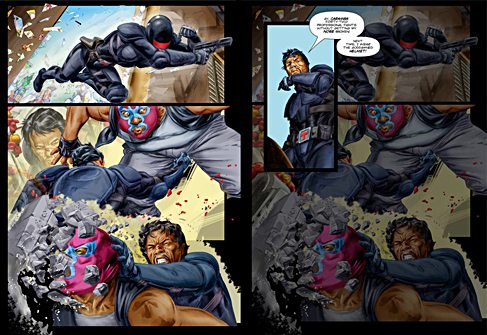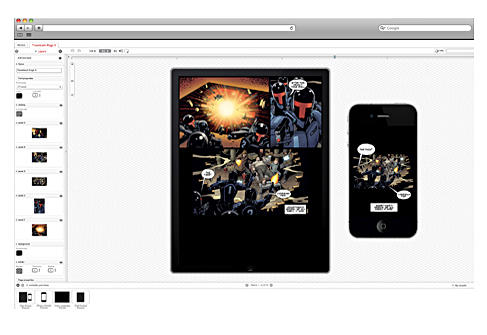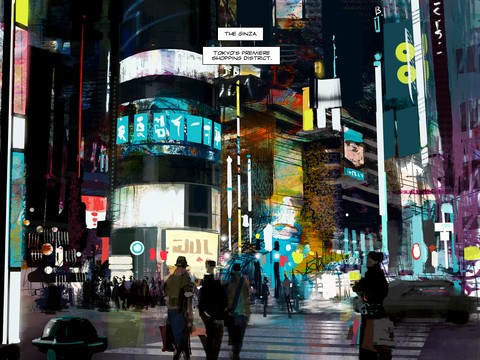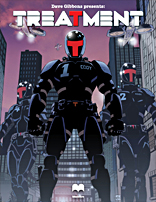Madefire: The Future of Comics?

Two “pages” from the title ‘Treatment, Mexico City: Episode 2’ Written by Robbie Morrison (Walking Dead, Batman) Art by Dougie Braithwaite (2000 AD, Universe X)
Where are comics heading at as an art form? Is Madefire a step forward in the evolution of the medium or is it a mere fad?
Comics are an hybrid art, placed somewhere between painting and literature. From the caves of Altamira, to the Famous Funnies and on to the latest Alex Ross cover, the art of comics has evolved tremendously. The creation, distribution and consumption of comics have shifted from analog to digital, from passive to interactive. Just as it happened to music, books and movies, the internet has also forced the adoption of new business models in order for the industry to survive.
Madefire appears as a proposal to evolve comics in every aspect. Co founders Ben Wolstenholme, Eugene Walden and renown Comic Artist Liam Sharp (Judge Dredd, Testament, Gears of War) got the ball rolling by raising over two million dollars from early stage venture capital firm True Ventures and angel investors of the likes of Flipboard CEO Mike McCue and Sina Tamaddon, former SVP of applications at Apple.
The platform seeks to innovate in every process of the production chain. They start off with their own creation tool, with which artists can digitally create comics specifically aimed for mobile touch screen devices. Their motion tool tries to free content producers from the 21 page standard comic format and involve a different concept of space, along with the introduction of movement and sound.

One of the most promising features of the Madefire platform is its web based “Motion Book Tool”
As a distribution platform, Madefire wants to become an outlet where the independent producers that adopt their motion tool can sell and profit from their creations without the need of the traditional publishing houses. The whole project is initially backed up with content created by big names like Dave Gibbons (Watchmen, Doctor Who, Green Lantern), Brian Bolland (Batman, Tank Girl, Lobo), and Mark Texeira (Swamp Thing, Hulk, Akira).
It’s no wonder why executives from the traditional giants like Ben Abernathy (DC Editor) are coming on board and betting on the project.
Comics have flirted for a long time with animation. Until now, every attempt to evolve the art of comics has been conceived around the idea of introducing movement inside the panels. This goes way back to the 2001 successful Flash animated “Broken Saints,” and the technique achieved it’s peek in 2009 with the critically acclaimed “GodKiller” which introduced 3D particles and other CGI gimmickry to the fold.

Is this the way we are going to experience are beloved comics in the future?
The Madefire concept isn’t new. In fact, they didn’t win the race for innovation not even in their own arena: mobile devices. Marvel launched their series of motion comics back in 2010 and last year we saw Stan Lee and independents like Josh Viola bringing playable experiments to the app store.

Fabulous cityscape from the title ‘Treatment, Tokyo: Episode 2’ Written by Robbie Morrison (Walking Dead, Batman) Art by Kinman Chan (Tom Clancy’s Rainbow Six, Mars Needs Moms)
But if you take a closer look at these prior experiments, you will notice why Madefire is the closest of all to really being the next big thing in the evolution of sequential art. Sure, the “Watchmen” motion comic and “Godkiller”are interesting to watch, but in the end they’re just half baked animations based on a comic book. They don’t bring anything new to the grammar or form of comic art. They are as revolutionary to the history of comics as pop-ups were revolutionary to the evolution of literature.
Madefire isn’t something to yell Shazam! either. It’s not an entirely new and revolutionary idea. Non the less, after you experience their titles you immediately get the feeling they’re on the right path. What you’re getting is still a comic book, but at the same time you’re also getting an experience that’s exclusive to a touch screen device. You’re not watching animation, or playing anything. You are still reading a comic book. First and foremost, Madefire is a reading experience.
Each of their titles makes full use of the iPad’s screen and look terrific both horizontally and vertically. The Madefire App will adjust the size and layout of the art based on how you are holding your device. Some titles have a preferred orientation and a small icon in the lower left hand corner will let you know if you’re holding your device accordingly, but to me every single panel looked stunning from any angle.
Each title takes approximately ten minutes to be read and experienced. The ever present music may be annoying for some people, but the overall experience is very pleasant and entertaining. Madefire should be appealing for traditional comic buffs and newbies alike.
Creators should keep a watchful eye to the public launch of their browser based motion tool in the upcoming months, which could be the first genuine step towards the evolution of comic books in a decade.
Madefire app is currently only available for Ipad and Iphone. You can download it for free from the App Store.
